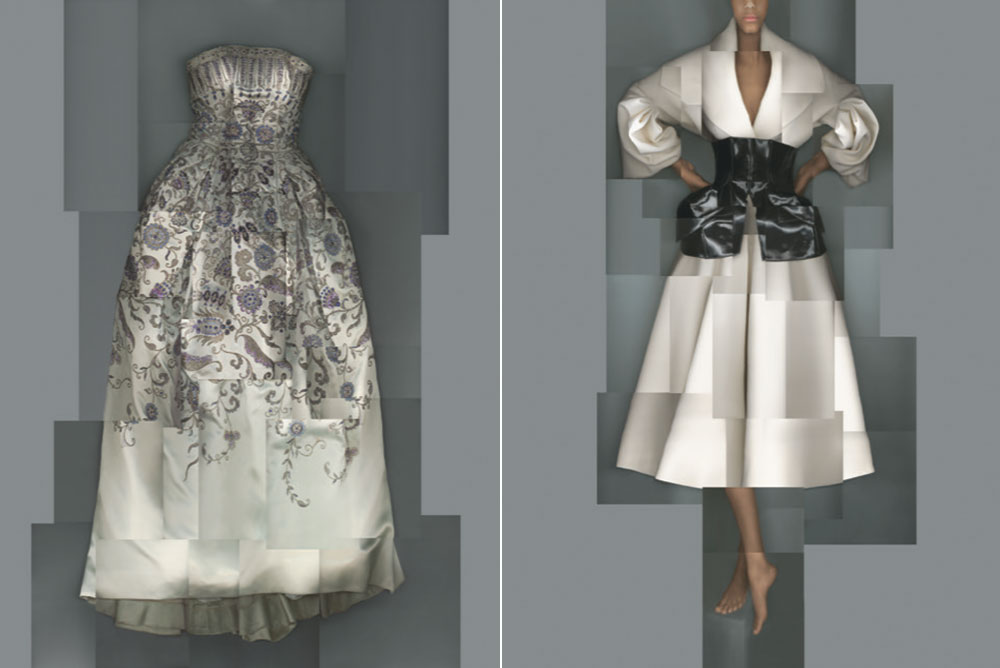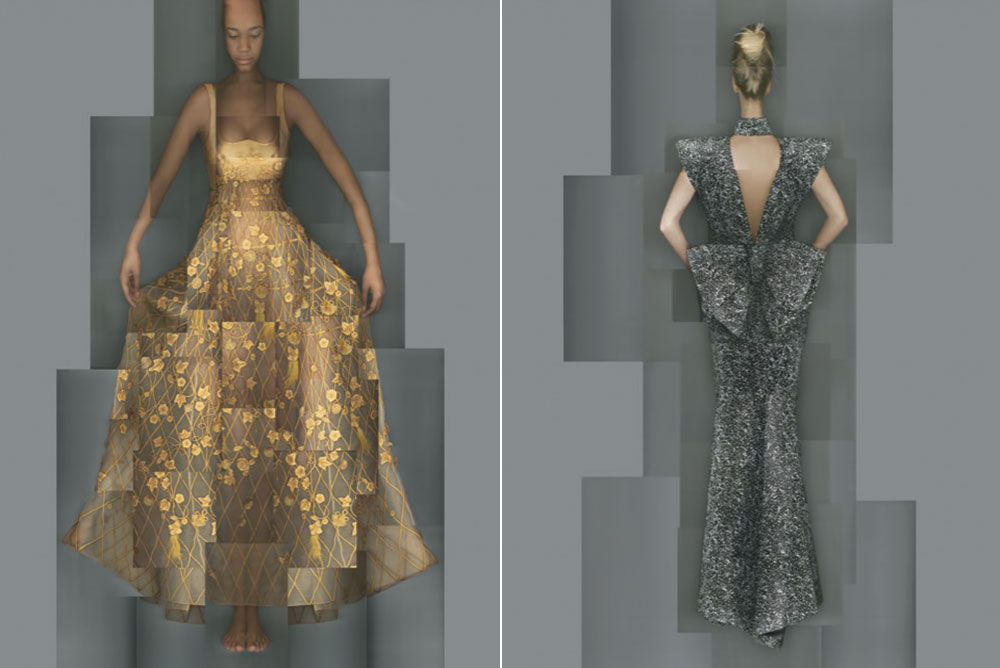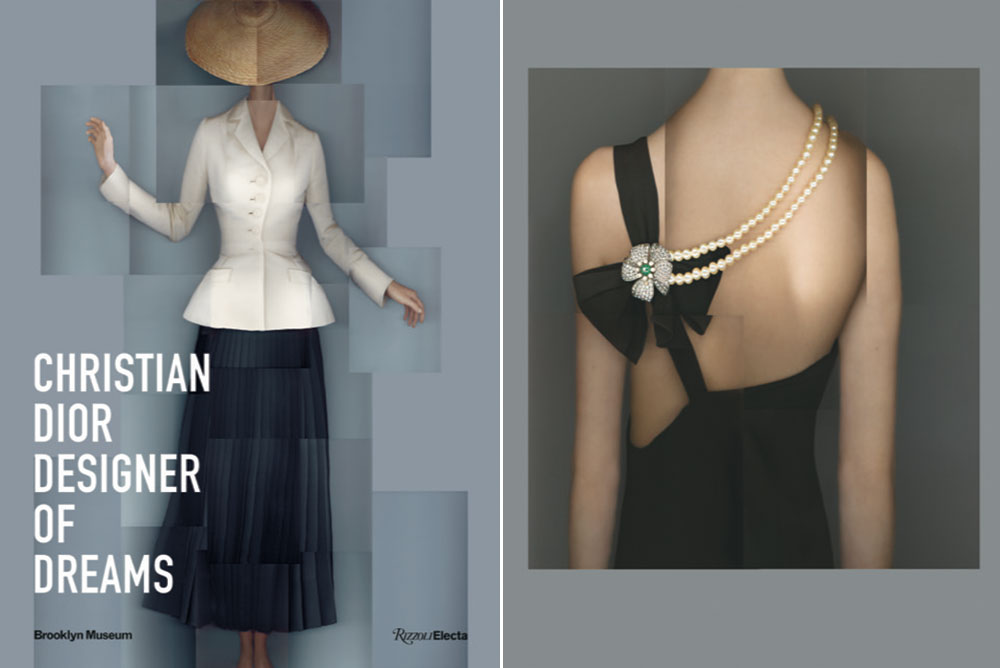
LEFT: The “Palmyre” evening dress of embroidered ice-blue satin, designed by Christian Dior for the Fall-Winter 1952 Haute Couture.
RIGHT: A cream wool coat worn with a patent-leather “Bar” belt, from the Fall-Winter 2008 Haute Couture, created by Christian Dior designer John Galliano. Photographic images by Katerina Jebb. From Christian Dior: Designer of Dreams, published by Rizzoli Electa.
By Janet Kelly
IF YOU can’t make it to the Brooklyn Museum of Art to see its blockbuster exhibition, visit vicariously by getting your hands on the book that accompanies the show.
Divided into discrete chapters, Christian Dior: Designer of Dreams, published by Rizzoli Electa, is written by a cast of experts, each from his/her own perspective.
Jérôme Gautier, Dior publishing director and author of Dior New Looks, describes the designer’s early career struggles and how opening Christian-Dior New York “transformed Parisian spirit into American ready-to-wear sold in the country’s biggest stores.” In another chapter, American design historian Maureen Footer provides context in which to view the success of Dior with an explanation of the workings of the haute couture in Paris, starting with Louis XIV. She maintains that the New Look (an ultra-feminine combination of rounded shoulders, a cinched waist and a very full skirt) was not only a fashion coup but an event “signaling that the world had turned a page.”
The evolution of the House of Dior is told through pictures from the exhibition of Christian Dior’s and subsequent designers’ creations. When Dior died of a heart attack in 1957, his 21-year-old assistant, Yves Saint Laurent, influenced by street fashion, gave Dior another new look—with his black crocodile mink-trimmed jacket. A star-studded list of famous designer names followed: Marc Bohan, who held the post for 30 years, was known for his sculpted silhouettes; Gianfranco Ferré for his architectural clothing; John Galliano for his unorthodoxy; Raf Simons—who now collaborates with Miuccia Prada—for his tailoring, and Dior’s current first female creative director, Maria Grazia Chiuri, for her conceptual designs calling attention to the issues of the day.

LEFT: The “Miss Dior” dress is embroidered with a lattice of flower and petal motifs, created by Christian Dior designer Maria Grazia Chiuri for the Spring-Summer 2021 Haute Couture.
RIGHT: This evening dress of black-and-white printed faille was created by Christian Dior designer Marc Bohan for the Fall-Winter 1986 Haute Couture. /
Photographic images by Katerina Jebb. From Christian Dior: Designer of Dreams, published by Rizzoli Electa.
It wouldn’t be a Rizzoli publication if weren’t illustrated with outstanding illustrations and photographs, and these from artist Katerina Jebb (shown) and the world’s most famous photographers do indeed dazzle.
Senior fashion curator at the Brooklyn Museum, Matthew Yokobosky, explains how Jebb used a scanner to deconstruct and then reassemble 35 of the House of Dior’s most famous designs into mosaic-like images—from the 1947 “Bar” suit (an ecru shantung jacket and black pleated wool crepe skirt) to a 2021 one-shoulder dress with a cascade of gold metallic fringes by Maria Grazia Chiuri.
The book concludes with a terrific portfolio of photographs from America’s most celebrated masters—including Richard Avedon, Irving Penn, Bert Stern, Horst, Louise Dahl-Wolfe, Annie Liebovitz and Deborah Turbeville—who captured celebrated beauties, top models (from Dovima to Christy Turlington), famous actresses (Elizabeth Taylor and Marilyn Monroe, to name just two) and rock stars (Rihanna) wearing Dior from the 1950s until today.

LEFT: Shown on the cover of Christian Dior: Designer of Dreams is the designer’s iconic “Bar” suit, creating “the New Look” for the Spring-Summer 1947 Haute Couture.
RIGHT: This is the “Chat Noir,” a black silk crepe dress adorned with two rows of pearls and created by Christian Dior designer Yves Saint Laurent for the Fall-Winter 1960 Haute Couture. / Photographic images by Katerina Jebb. From Christian Dior: Designer of Dreams, published by Rizzoli Electa.

I’m going to pass on this book — here’s why:
I saw the Dior show when it was in Dallas and it was a knockout!
The original post-War designs are still chic — I would wear any of them.
Fabrics — oh my! From restrained black and white to super-saturated reds.
A friend saw the Brooklyn Museum show and raved about the exhibition design. Inventive and really showed off the garments.
She brought me a set of postcards with photos by Katerina Jebb.
The photos did a disservice to the clothing. They struck me as dark, drab, dour. Not a shred of the joy or emotion of the fabrics and fashion. Are those real models in the photos or mannequins? With Jebb’s broken-up and re-assembled images you can’t tell. Maybe it doesn’t matter.
If I see this book on the close-out table, I’d buy it — not for Jebb’s photos but for the writing and the photos of Avedon, Stern, Penn, etc.
You certainly have a point about the book, which I didn’t really think about when I purchased it! It’s just someone’s art project, even though obviously bought and paid for by the brand. Has nothing really to do with fashion–but I did like reading the text in the comfort of my own home, not standing on marble (or whatever) floors in a museum.
The show has been mounted at a number of places around the country and the world, and each time it changes a bit, or so I understand. My interest flagged in the closing “color saturation” displays in Brooklyn, where current Dior products were stowaways among the historical antifacts. But overall, as you point out, it was a dazzler!
Wow. We’re planning to go to Brooklyn in December, right? And the book looks amazing. May even buy it.
It’s a stunning book. Photos are luscious.